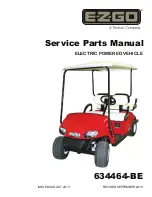
Page B-2
Repair and Service Manual
B
Read all of Section B and this section before attempting any procedure. Pay particular attention to Notices, Cautions, Warnings and Dangers.
SAFETY
powertrain.
Use care not to contact hot objects.
Any servicing requiring adjustments to be
made to the powertrain while the motor is
running must be made with both wheels
raised.
To prevent the possibility of motor
disintegration, never operate vehicle at full
throttle for more than 4 - 5 seconds while
vehicle is in a “no load” condition.
Wear OSHA approved clothing and eye
protection when working on anything that
could expose the body or eyes to potential
injury. In particular, use care when working
with or around batteries, compressed air or
solvents.
Always turn the key switch to ‘OFF’ and
remove the key before disconnecting a live
circuit.
When connecting battery cables, pay par-
ticular attention to the polarity of the battery
terminals. Never confuse the positive and
negative cables.
The parking ‘PARK’ brake should always
be set, except for cases where the power-
train must be allowed to rotate or service is
being performed on the brake system.
If repairs are to be made that will require
welding or cutting, the batteries must be
removed.
Additional Warnings
Before working on the electrical system, be sure to read
and understand the following warnings that pertain to
electrical system repair or maintenance.
To prevent battery explosion that could result
in severe personal injury or death, keep all
smoking materials, open flame or sparks away
from the batteries.
Hydrogen gas is generated in the charging
cycle of batteries and is explosive in
concentrations as low as 4%. Because
hydrogen gas is lighter than air, it will
collect in the ceiling of buildings
necessitating proper ventilation. Five air
exchanges per hour is considered the
minimum requirement.
Be sure that the key switch is off and all
electrical accessories are turned off before
starting work on vehicle.
Batteries should always be removed before
any servicing or repairs that could generate
sparks.
Never disconnect a circuit under load at a
battery terminal.
Batteries are heavy. Use
proper lifting techniques when
moving them. Always lift the
battery with a commercially
available battery lifting device.
Use care not to tip batteries
when removing or installing
them; spilled electrolyte can
cause burns and damage.
The electrolyte in a storage battery is an
acid solution which can cause severe burns
to the skin and eyes. Treat all electrolyte
spills to the body and eyes with extended
flushing with clear water. Contact a
physician immediately.
Wear eye protection when
working on the vehicle. In par-
ticular, use care when working
around batteries, or using
solvents or compressed air.
Any electrolyte spills should be neutralized
with a solution of 1/4 cup (60 ml) sodium
bicarbonate (baking soda) dissolved in
1 1/2 gallons (6 liters) of water and flushed
with water.
Wrap wrenches with
vinyl tape to prevent the
possibility of a dropped
wrench from ‘shorting
out’ a battery, which could result in an
explosion and severe personal injury or
death.
Aerosol containers of battery terminal
protectant must be used with extreme
care. Insulate metal container to prevent
can from contacting battery terminals which
could result in an explosion.

































